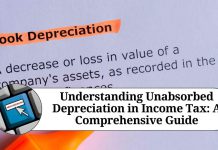Introduction
Section 43CA of the Income Tax Act, 1961 is a provision that deals with the taxation of certain transactions related to immovable property. This provision was introduced by the Finance Act, 2013 to address certain loopholes in the taxation of such transactions. In this blog, we will take a closer look at Section 43CA and understand its provisions and implications.
Applicability of Section 43CA
Section 43CA applies to transactions related to transfer of immovable property that are not covered under Section 50C. Section 50C of the Income Tax Act applies to transactions involving the sale of land or building or both, where the sale consideration is less than the stamp duty value. In such cases, the stamp duty value is considered as the full value of consideration for the purpose of computing capital gains. However, if the sale consideration is more than the stamp duty value, the actual sale consideration will be considered as the full value of consideration.
Provisions of Section 43CA
Under Section 43CA, if the consideration received or accruing as a result of transfer of an immovable property is less than the stamp duty value, then the stamp duty value will be deemed to be the full value of consideration for the purpose of computing income under the head “Income from Capital Gains”. In other words, the difference between the stamp duty value and the consideration received or accruing from the transfer of the property will be deemed as the income of the transferor for the year in which the transfer took place.
Exceptions to Section 43CA
Section 43CA does not apply in certain cases. For instance, if the transfer is made to a government authority or to any other specified entity, the provisions of Section 43CA will not apply. Similarly, if the transfer is made under a scheme of amalgamation or demerger, the provisions of Section 43CA will not apply.
Implications of Section 43CA
Section 43CA has significant implications for taxpayers who transfer immovable property. If the consideration received or accruing from the transfer is less than the stamp duty value, the taxpayer will have to pay tax on the difference between the two amounts. This means that taxpayers cannot undervalue the consideration received from the transfer of immovable property in order to reduce their tax liability. They will have to pay tax on the stamp duty value even if they receive a lower consideration.
While Section 43CA of the Income Tax Act has been introduced to prevent tax evasion, it has also led to some controversies and debates. One of the main issues is related to the stamp duty value, which is determined by the state government and can sometimes be higher than the market value of the property. This means that taxpayers may have to pay tax on a higher value than what they actually received from the transfer.
Another issue is related to the enforcement of the provision. Since the provision is relatively new, there is still a lack of clarity on how it will be enforced and what penalties will be imposed for non-compliance. This has led to confusion and uncertainty among taxpayers, who are unsure about how to comply with the provision.
To address these issues, the government may need to provide more clarity on the calculation of stamp duty value and the enforcement of the provision. This can be done through the issuance of guidelines and circulars by the tax authorities. The government may also consider introducing penalties for non-compliance with the provision, in order to ensure that taxpayers do not undervalue the consideration received from the transfer of immovable property.
It is worth noting that Section 43CA of the Income Tax Act has been introduced as part of a larger effort by the government to curb tax evasion and increase tax compliance. The government has taken several steps in recent years to strengthen tax laws and improve tax administration, including the introduction of the Goods and Services Tax (GST) and the implementation of the Direct Tax Vivad Se Vishwas scheme.
Section 43CA is also in line with international best practices in tax administration, where governments are increasingly using technology and data analytics to identify potential tax evaders and improve tax compliance. The use of technology and data analytics can help tax authorities to identify cases where taxpayers may be undervaluing the consideration received from the transfer of immovable property and take appropriate action to enforce the provision.
In addition to improving tax compliance, Section 43CA can also have a positive impact on the real estate sector. By ensuring that taxpayers pay taxes on the correct value of the consideration received from the transfer of immovable property, the provision can help to reduce the incidence of black money in the sector and increase transparency. This can improve investor confidence in the sector and attract more investments, which can have a positive impact on the overall economy.
Conclusion
Section 43CA is an important provision in the Income Tax Act that aims to prevent tax evasion by ensuring that taxpayers do not undervalue the consideration received from the transfer of immovable property. The provision has significant implications for taxpayers, who must ensure that they receive a consideration that is at least equal to the stamp duty value of the property being transferred.
Read more useful content:
Frequently Asked Questions (FAQ’s)
- What is Section 43CA of the Income Tax Act?
Section 43CA is a provision in the Income Tax Act that requires taxpayers to pay taxes on the stamp duty value of immovable property transferred in certain cases.
2. When does Section 43CA apply?
Section 43CA applies when immovable property is transferred for a consideration that is less than the stamp duty value, and the difference between the consideration and the stamp duty value exceeds a certain threshold.
3. What is the penalty for non-compliance with Section 43CA?
If a taxpayer does not comply with the provisions of Section 43CA, they may be subject to a penalty of up to 200% of the tax due.
4. Can taxpayers challenge the stamp duty value determined by the state government?
Taxpayers can challenge the stamp duty value determined by the state government if they believe it is incorrect or unreasonable. However, they need to provide evidence to support their claim.
5. Does Section 43CA apply to all types of immovable property?
Section 43CA applies to all types of immovable property, including land, buildings, and commercial property.
6. Are there any exemptions to Section 43CA?
There are no exemptions to Section 43CA. However, the provision does not apply if the transfer is made to a government authority, a local authority, or a statutory corporation.
7. What is the threshold for the difference between the consideration and the stamp duty value?
The threshold for the difference between the consideration and the stamp duty value is 10%.
8. Can taxpayers claim deductions for expenses related to the transfer of immovable property?
Taxpayers can claim deductions for expenses related to the transfer of immovable property, such as brokerage fees, legal fees, and stamp duty paid.
9. How can taxpayers calculate the tax liability under Section 43CA?
Taxpayers can calculate the tax liability under Section 43CA by multiplying the difference between the consideration and the stamp duty value by the applicable tax rate.
10. Is Section 43CA applicable to inherited property?
Section 43CA is not applicable to inherited property, as there is no consideration involved in the transfer of inherited property.

































